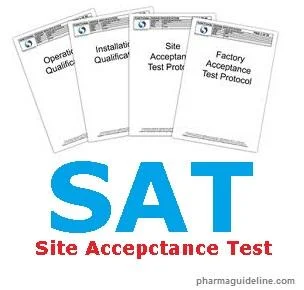Site Acceptance Test can determine whether or not systems are meeting the desired and required specifications. The main purpose of site acceptance testing is to give an overall evaluation of a system's compliance and to ensure this compliance meets the requirements of the business involved. Site acceptance testing can be useful in relation to criteria testing for optimum results of systems.
The factory acceptance tests (FAT) are inspections that use the same principle, are more focused on whether the user requirements meet specification, and be executed by not only the client but the client representative. They take both the manufacture and the user into account and are, like their title suggests, tested at the factory/place of manufacturing.
In the biotech, medical and pharmaceutical fields, these tests are common knowledge. Site acceptance test documents need to be completed routinely in order for systems to meet GMP requirements. Without the SAT tests, it is difficult to see if these requirements are successfully complied with.
Essentially, the SAT ensures all controlling and manufacturing of medicinal products meet the standards of confidence the legislation agreements expect them to make.
All results from SAT need to be monitored and recorded before being resourced with the appropriate personnel. The SAT also has to transfer across premises, facilities and equipment so need to be a test that can be conducted across the borders.
There are various elements of a Site Acceptance Test that will be included in the test to ensure its success.
These include: Finishing visual checks, main components visual checks, internal box pressure and ventilation setting checks, the functionality of utilities to be checked, the interlocks to be checked in relation to functionality, a hot test for dispensing systems, calibrator verifications, safety devices checks and tests of the operator’s training and ability.
Site acceptance tests are of huge importance as they allow for a system to prove it is up to the job and can achieve its goals safely. Which in turn, makes the user safe. FAT’s ensure the manufacturer is also safe, so the use of both acceptance tests is absolutely necessary.
Issues can be rectified before they have the potential to cause damage or harm, which also allows for projects to be kept on track and, if applicable, on budget. Site acceptance tests aren’t just used in the pharmaceutical fields. They stem across all borders of engineering, even into traffic signal equipment! By conducting an SAT all users are able to acknowledge a system is doing its job right.
The factory acceptance tests (FAT) are inspections that use the same principle, are more focused on whether the user requirements meet specification, and be executed by not only the client but the client representative. They take both the manufacture and the user into account and are, like their title suggests, tested at the factory/place of manufacturing.
In the biotech, medical and pharmaceutical fields, these tests are common knowledge. Site acceptance test documents need to be completed routinely in order for systems to meet GMP requirements. Without the SAT tests, it is difficult to see if these requirements are successfully complied with.
Essentially, the SAT ensures all controlling and manufacturing of medicinal products meet the standards of confidence the legislation agreements expect them to make.
All results from SAT need to be monitored and recorded before being resourced with the appropriate personnel. The SAT also has to transfer across premises, facilities and equipment so need to be a test that can be conducted across the borders.
There are various elements of a Site Acceptance Test that will be included in the test to ensure its success.
These include: Finishing visual checks, main components visual checks, internal box pressure and ventilation setting checks, the functionality of utilities to be checked, the interlocks to be checked in relation to functionality, a hot test for dispensing systems, calibrator verifications, safety devices checks and tests of the operator’s training and ability.
Site acceptance tests are of huge importance as they allow for a system to prove it is up to the job and can achieve its goals safely. Which in turn, makes the user safe. FAT’s ensure the manufacturer is also safe, so the use of both acceptance tests is absolutely necessary.
Issues can be rectified before they have the potential to cause damage or harm, which also allows for projects to be kept on track and, if applicable, on budget. Site acceptance tests aren’t just used in the pharmaceutical fields. They stem across all borders of engineering, even into traffic signal equipment! By conducting an SAT all users are able to acknowledge a system is doing its job right.



No comments:
Post a Comment
Please don't spam. Comments having links would not be published.